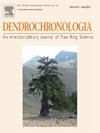群落级树木生长信号在热带森林恢复中的意义
IF 2.7
3区 农林科学
Q1 FORESTRY
引用次数: 0
摘要
生态恢复是一个全球性的需求,特别是在热带地区。树木年代学研究可以增加热带恢复项目的基础知识和应用知识。在这里,我们探讨了大西洋雨林恢复计划中的树木是否形成易于交叉测年和气候信号分析的生长年轮。我们分析了分布在两个恢复林分中18个最常见树种的43棵树。来自所有物种的树木(35棵)证明了交叉数据的生长年轮,使我们能够构建一个强大的多物种年轮宽度年表。热带地区这种前所未有的社区信号是由树木生长对水分和温度的滞后一年的反应决定的。非结构性碳水化合物(NSC)的动态可能参与了这种延迟的气候效应。林分树木之间相对均匀的光照条件对于检测生长信号至关重要。这种群落水平的信号是否会在其他地方发现,以及NSC在调节树木生长对气候的响应中的作用值得进一步研究。树木年轮分析使我们能够评估正在恢复的森林群落的气候敏感性,并可以进一步解决恢复热带生态系统的其他几个相关问题。另一方面,修复项目为推进热带树木年代学提供了一个独特的实验环境。本文章由计算机程序翻译,如有差异,请以英文原文为准。
On the meaning of community-level tree-growth signal in a tropical forest restoration
Ecological restoration is a global need, particularly in the tropics. Dendrochronological research could boost basic and applied knowledge for tropical restoration projects. Here, we explored whether trees in restoration programs of the Atlantic Rainforest form growth rings prone to crossdating and analysis of climatic signals. We analyzed 43 trees distributed across the 18 most common species in two restoration stands. Trees (35) from all the species evidenced crossdatable growth rings, allowing us to construct a robust multi-species ring-width chronology. This unprecedented community-level signal in the tropics was determined by a one-year lagged tree-growth response to water availability and temperature. The dynamics of non-structural carbohydrates (NSC) are likely involved in this delayed climatic effect. Relatively homogeneous light conditions among trees in the stands would be critical for detecting the growth signal. Whether such a community-level signal would be found elsewhere and the role of NSC in mediating tree growth responses to climate deserve further investigation. Tree-ring analysis allowed us to assess the climatic sensitivity of a forest community undergoing restoration and could further address several other relevant issues towards restoring tropical ecosystems. On the other hand, restoration projects offer a unique experimental setting to advance tropical dendrochronology.
求助全文
通过发布文献求助,成功后即可免费获取论文全文。
去求助
来源期刊

Dendrochronologia
FORESTRY-GEOGRAPHY, PHYSICAL
CiteScore
5.50
自引率
13.30%
发文量
82
审稿时长
22.8 weeks
期刊介绍:
Dendrochronologia is a peer-reviewed international scholarly journal that presents high-quality research related to growth rings of woody plants, i.e., trees and shrubs, and the application of tree-ring studies.
The areas covered by the journal include, but are not limited to:
Archaeology
Botany
Climatology
Ecology
Forestry
Geology
Hydrology
Original research articles, reviews, communications, technical notes and personal notes are considered for publication.
 求助内容:
求助内容: 应助结果提醒方式:
应助结果提醒方式:


